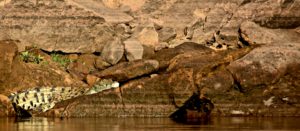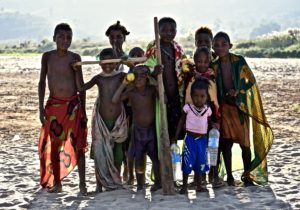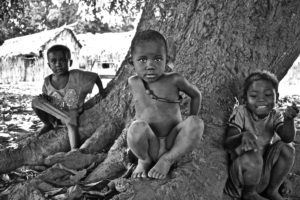Into Madagascar’s Wild West — Part II
To Read Part One Click Here. The tributary was still too shallow to embark, so we waded half a kilometer through the muddy point-bar, trousers rolled up, trying not to sink in the sludge. Each step in the water stirred up a brilliant cloud of ‘meco’ flakes — miniscule golden particles that densely populated the river, scintillating brightly from the sunrise. Once we reached deep enough water, we precariously boarded the pirogues and commenced our three-day river journey. We were guided masterfully by Antsirabe-born G.M. (anonymous due to comments made later about the Malagasy government’s security corruption) due to his expert knowledge of the Tsiribihina and Menabe areas., Meanwhile, Didi used a miniscule paddle to row sixty plus kilometers down river.
We set off into serenity. The shrubs fringing the banks obstructed all wind, the water surface like glass, still with meco flakes coruscating at every paddle stroke. Passersby — fisherman, cargo transporters, farmers — warmly extended greetings of “Salama” (hello), which we always reciprocated with “Salame”, and vice versa. The children that spotted us from the banks ran alongside as long as they could, excitedly yelling “vaza!” (meaning white foreigner in Malgache). After a gentle morning, the tributary led to the river, ushering in dramatic landscape changes. The once flat banks topped by fields had become small mountains and dramatic escarpments, with layers of sedimentary rocks running parallel into the distance. Some hills still had tree-cover, while others were razed bare.

Each different bank geography harbored abundant wildlife. Since Madagascar and India used to touch before continental shift, a lot of my favorite animals I had come to adore in India were here; Drongos — known as the king of birds in Madagascar — and Paradise Fly-Catchers were perched atop tall trees. The low shrubs were dotted by masses of dramatic-colored butterflies and were used by Kingfishers and Bee-Eaters for fishing, as they swooped at incredible speeds in front of the pirogue. Even the seemingly bare rocks proved to be excellent basking space for Madagascar Ground Boas and juvenile Nile Crocodiles.

After a long day scorched under the sun, we arrived at a sloping mud bank — our campsite. A short walk inland revealed an immaculate network of crystal-blue pools and waterfalls, the depths covered in a delicate white dusting. We shared the camp-spot with a Malgache family, and after dark, they treated us to beautiful Malgache campfire songs.
The next morning, we set off at daybreak. After a few tranquil hours, pleasantly uneventful, we disembarked at the village of Begidro. In the center was a tobacco storage warehouse as well as a crowded open market. The smell of fish caught that morning wafted throughout the air and caught the attention of what looked to be all the flies and bees in the vicinity. The women who were bringing the fish from the banks to the center were wearing a yellow face paste, made from Tsiambara roots, as protection from sunburns.
 With a cloudless sky, we pushed on under the roasting sun. That night, we were to camp on a flat sand bank with the company of Sakalava peoples. The Sakalava are the ethnic tribes that populate the dry west of Madagascar — dry, due to the rain-shadow caused by the mountains in the east. Their livelihoods depend on agriculture and zebu (cattle) rearing, and they dress in vivid ‘lamba’ shrouds. The children on the banks spotted us hundreds of meters away, and rushed to welcome us. They spent the whole evening enthusiastically sharing their hand gestures and games; before we knew it, twilight had turned to night. Around a raging fire, the young boys showed us their traditional ‘Mahai’ dance, and tried to get us to join — not only were we lousy at replicating the meticulous moves, we were exhausted after only three rounds! During a real ceremony, the boys are expected to dance until sunrise. Once the fire was out and everyone had gone to bed, I looked up at the sky. Clear of clouds and civilization’s light, the night sky was filled with countless stars. This was the first time I had seen the Milky Way since childhood. Far away from cities and roads, the stars were just a reminder of how special of a place this was.
With a cloudless sky, we pushed on under the roasting sun. That night, we were to camp on a flat sand bank with the company of Sakalava peoples. The Sakalava are the ethnic tribes that populate the dry west of Madagascar — dry, due to the rain-shadow caused by the mountains in the east. Their livelihoods depend on agriculture and zebu (cattle) rearing, and they dress in vivid ‘lamba’ shrouds. The children on the banks spotted us hundreds of meters away, and rushed to welcome us. They spent the whole evening enthusiastically sharing their hand gestures and games; before we knew it, twilight had turned to night. Around a raging fire, the young boys showed us their traditional ‘Mahai’ dance, and tried to get us to join — not only were we lousy at replicating the meticulous moves, we were exhausted after only three rounds! During a real ceremony, the boys are expected to dance until sunrise. Once the fire was out and everyone had gone to bed, I looked up at the sky. Clear of clouds and civilization’s light, the night sky was filled with countless stars. This was the first time I had seen the Milky Way since childhood. Far away from cities and roads, the stars were just a reminder of how special of a place this was.

After an affecting goodbye in the morning, we completed the final part of the river journey. As we came up to the village of Tanambao, we were thoroughly impressed by a child, no more than six years old, piloting a pirogue on his own. He was from the village and hurried back to announce our arrival. Once there, we hopped on a rickety zebu-cart across the expanse of rice paddies. Max, Joe, and I were squeezed into the wooden frame, and felt every bump on the way. The road was more of a dirt trail with serious ditches, which were part of the intricate irrigation system of the farming area. Some of the ditches had water so deep that we had to shift all our weight to the front, as the back of the cart was submerged. Once we arrived at Antsiraraka, we met Rolland, who took us through the last leg to the Tsingy, which was only possible by 4X4. After passing by a span of baobabs on rich-red shabby dirt roads and making a river crossing on a car-transport boat, we made it to Belo-sur-Tsiribihina for the night. The following day, we were to arrive at our campsite in Bekopaka before exploring the Tsingy de Bemaraha national park. In this process, we unexpectedly discovered special Malgache traditions in both places: pre-Independence Day celebrations.
